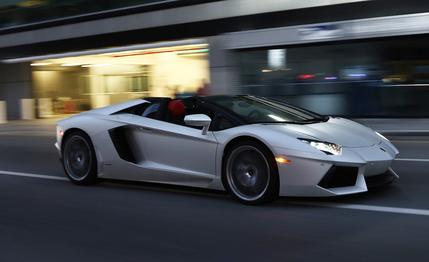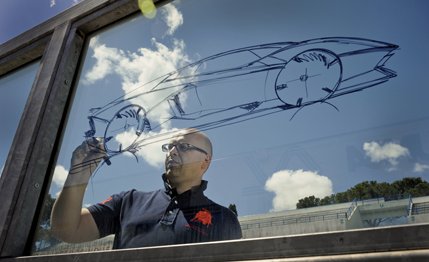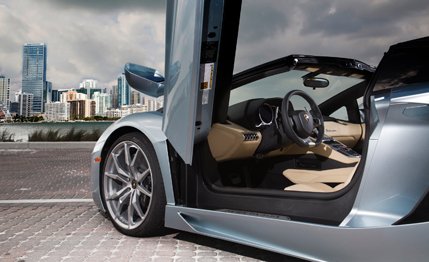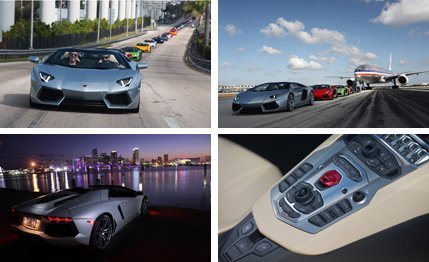 First Drive Review
First Drive Review
“Everyone serves the good wine first, and then the inferior wine after the guests have become drunk. But you have kept the good wine until now.” John 2:10.
Lamborghini’s Aventador Roadster, arguably the best varietal ever bottled by the Sant’Agata Bolognese winery, is the perfect way to celebrate 2012 global sales up by 30 percent, a healthy backlog of Aventador orders, and the company’s 50th birthday. While the rest of the car world frets electrics and hybrids, Lamborghini is toasting its middle age with a $448,295 dolce spumante.

 Filippo Perini, head of Lamborghinis 8-person Centro Stile design department, is the companys ambassador for intentionally outrageous road sculpture
and a crack problem solver. Distinguishing between stylists and designers while casually sketching two views of the Aventador Roadster, he explains, Its our job to go well beyond pure art. We also solve functional issues, such as how air flows through the heat exchangers and the influence of aerodynamic features on high-speed stability. Perini revealed that his inspiration for the Aventador came from those shiny-green jagged-leg beetles that smell bad when you step on them, the F-22 and F-35 fighters, and the B2 stealth bomber.
Filippo Perini, head of Lamborghinis 8-person Centro Stile design department, is the companys ambassador for intentionally outrageous road sculpture
and a crack problem solver. Distinguishing between stylists and designers while casually sketching two views of the Aventador Roadster, he explains, Its our job to go well beyond pure art. We also solve functional issues, such as how air flows through the heat exchangers and the influence of aerodynamic features on high-speed stability. Perini revealed that his inspiration for the Aventador came from those shiny-green jagged-leg beetles that smell bad when you step on them, the F-22 and F-35 fighters, and the B2 stealth bomber.
This is hardly the first time a manufacturer has popped the cork on a coupe to woo sun worshippers, but there’s more to this Roadster (which is actually a targa) than solar-heated seats. To minimize the loss of structural integrity, its carbon-fiber tub is reinforced with thicker rocker sections and additional composite material laid over the driveline tunnel and firewall.

With the two gloss-black roof panels removed, torsional stiffness is 37-percent lower than the coupe’s but, short of a lab measurement or bad-road, sibling comparison test, you’ll never notice the slightly softer foundation. Resealing the cockpit by plugging the top panels’ locating pins into four windshield sockets and securing two rear latches restores 6 percent of the lost stiffness.
Each top panel weighs only 13.2 pounds thanks to the Lamborghini’s first application of its forged-composite process, which squeezes 1-to-2-inch carbon fibers laced with resin and packed into a precise mold in a heated 1100-ton press. To bask in the admiring paparazzi glow, you plug the tops into receivers fitted to the trunk. That consumes 90 percent of the limited luggage space, a problem for your valet to resolve.

Other Roadster-specific features are twin pop-up B-pillar posts that deploy in the unlikely event of a rollover, side-window glass beveled along its top edges for tight sealing, and a small glass panel between the rear roof pillars that can be lowered to orchestrate the back breeze and V-12-engine serenade. The total weight gain is a modest 110 pounds.
While sculpting the original Aventador, Lamborghini’s chief designer Filippo Perini drew inspiration from shiny green beetles with zigzag legs, the F-22 Raptor, and the B-2 stealth bomber. His team added a few stylish hexagons to the Roadster to underscore Lamborghini’s admiration of the sixth element—carbon. Four overlapping tempered-glass panes set inside two elongated hexagons solve the problems of maintaining a view of the engine while venting heat and providing weather protection. Other hex shapes surround the exhaust pipes, cover the fuel filler, define the door openings, and guard the engine stop-start button against accidental use.